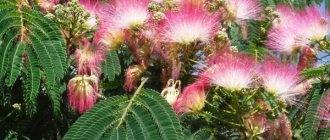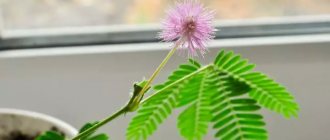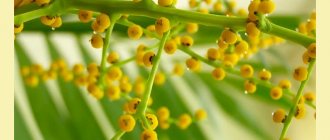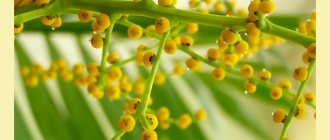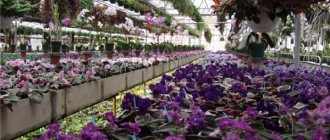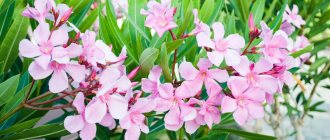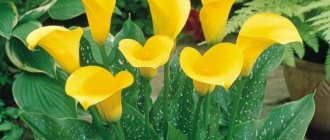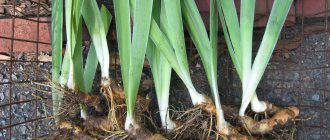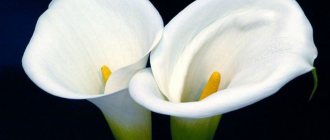The popularity of mimosa is that the process of its flowering begins immediately after the end of winter and ends almost at the very beginning of spring, which is why mimosa is considered to be a “harbinger of spring” in many countries.
Mimosa is a genus of flowering plants from the legume family. The most famous in the world is the bashful mimosa, but in Russia mimosa is mistakenly called a completely different plant - silver acacia or white acacia, which is part of the genus Acaciaceae of the same family.
Below, when describing how to grow mimosa at home, silver acacia will also be included.
Description of mimosa bush
Despite the variety of plant varieties, there is a general description that unites them:
- The crown consists of brown shoots with small cracks.
- The plant has a thorny trunk and small dissected leaves.
- Depending on the growing region, the first mimosa flowers may appear in mid-January.
- Mimosa flowers look like fluffy yellow balls.
Flowering can cause inconvenience to allergy sufferers; you should be aware of this and do not grow such a plant at home.
Basic rules for growing mimosa
The table provides brief rules for caring for mimosa at home.
| Lighting level | Bright, diffused light is preferred. |
| Content temperature | Moderate from March to September (up to +24 degrees), in winter a little lower - up to +18 degrees. |
| Watering mode | In spring and summer, you need to water the plant often; in the cold season, the rate is reduced. |
| Air humidity | The humidity level should be high. It is recommended to spray the flower every day with moderately warm water or keep the flower on a tray with wet expanded clay. |
| The soil | The soil includes equal shares of peat, turf, sand and humus. |
| Feeding | Carry out twice a month, but only during the growing season. The dosage of mineral fertilizers should be half the amount indicated on the pack. |
| Transfer | This is done only when necessary, because mimosa is usually grown as an annual. It is best to replant it in the spring, at the beginning of the growth phase. |
| Trimming | The flower does not need regular pruning of leaves. |
| Bloom | The flowering period lasts from spring to the end of August. |
| Rest period | The rest period is conditional; in winter it simply slows down its growth rate slightly. |
| Reproduction | Seed. Many species can also be propagated by cuttings; this method is usually used in greenhouse cultivation. |
| Pests | Aphids and spider mites. |
| Diseases | Stretching or yellowing of foliage is usually caused by lack of care or unfavorable environmental factors. |
Features of plant flowering
Gardenia in bloom - what an indoor and outdoor plant looks like
Growing indoor mimosa is not as difficult as achieving abundant flowering. The plant reacts sensitively to the slightest conditions of maintenance and care. Therefore, it requires attention and care not only during the formation of flower buds, but throughout the year.
Period of activity and rest
The active phase of plant development and growth is limited to the period between mid-spring and late autumn. During this period, the bashful beauty requires abundant watering, spraying and systematic feeding with fertilizers.
During the dormant period, the plant should be watered only when the top layer of soil in the pot dries. Low room humidity can be compensated with a cup of water placed next to the flower pot. Any kind of fertilizing in winter is categorically excluded.
Types and shape of flowers
Botanists have studied and described more than 600 species of mimosa. The most common in the European part of the continent are 3 types:
- bashful mimosa. Its pink-lilac flowers are collected in the shape of a ball and consist of four parts;
- rough (lat. Mimosa Scabrella). The flowers are collected in lush panicles of bright yellow color;
- lazy (lat. Mimosa Pigra). The spherical inflorescences are white.
Blooming Mimosa Scabrella
Most species known to science are perennial shrubs and are widely used for decorative planting.
Agricultural technology for growing mimosa on a personal plot
- Selecting a landing location. Since the plant is still a “resident” of tropical areas, it is problematic to grow it in our climate zone; for this purpose, mimosa is kept in rooms or greenhouses, greenhouses or winter gardens. Otherwise, the plant is grown as an annual, since by the autumn days the shoots become very elongated and the bush loses its attractiveness, but it is easy to renew it from seeds. If you are in a climate where winters are mild, then you should choose a place in a sunlit area - in the south, southeast, southwest, east or west. All this is because in shading, silver acacia will lose its decorative appearance, and you may not wait for flowering. And only in the presence of bright solar insolation is a mimosa able to form a compact bush or bloom profusely. The landing site must be protected from the wind. However, if the plant is immediately planted on the south side, sunburn may occur on the leaf blades. Therefore, at first, until adaptation takes place, a little shading is carried out. For mimosa, slow development and a slow set of height parameters are noted.
- Temperatures when growing mimosa in winter should not fall below 10 degrees below zero.
- The soil for planting mimosa is selected taking into account its natural “predilections”. The optimal composition of the substrate is a composition of the top soil layer (turf), peat, river sand and prepared humus. All parts of the components are equal. It is recommended to lay a layer of middle fraction expanded clay at the bottom of the hole - this will protect the root system from waterlogging. If the plant is grown as a perennial, it will need replanting in the spring. It is recommended to periodically loosen the soil and remove weeds.
- Watering. Growing mimosa requires normal conditions of humidity and watering; naturally, in natural conditions, the weather decides everything. However, if the summer is very hot, you will sometimes have to water the silver acacia, although the plant is drought-resistant. It is advisable to use collected rain or river water, but if this is not available, then tap water is passed through a filter, boiled and allowed to settle for a while. Then the water from the container is carefully drained so as not to capture sediment. Watering at first is necessary until complete rooting, when the plant has just been transplanted.
- Fertilizing the substrate. For mimosa, it is recommended to fertilize in the spring and summer, when the process of active vegetation and flowering is underway. You can use complete mineral complexes dissolved in water for irrigation twice a month, and when flowers appear, use preparations for beautifully flowering plants.
- General care for mimosa is not difficult, since you don’t even have to mold the plant’s crown. However, if silver acacia is used as a perennial, it is recommended to cut off shoots of the plant that are too elongated. If there is enough light, mimosa will quickly make up for their loss.
Caring for mimosa at home
Lighting
Mimosa growing in a pot requires a lot of sunlight. At the same time, the plant is not afraid of direct rays; it only needs to be shaded during particularly hot hours or use a diffusing screen. This allows you to keep a pot of mimosa on the southern windows, but western and eastern directions are also suitable for it. At the same time, a sudden change of environment to a sunny one can harm an unprepared mimosa. When moving a flower into the light from a shady place or after a long period of cloudy weather, it is shaded for some time to avoid sunburn, gradually accustoming it to more intense lighting.
In the shade, mimosa loses its decorative effect, its leaves begin to turn pale and grow old, and you can’t wait for flowering at all. At the same time, the plant does not like artificial lighting.
Temperature
From March until the onset of autumn cold, mimosa is kept in a room with a temperature of no more than +25 degrees. The plant does not like heat. In winter, relative coolness will be optimal - from +15 to +18 degrees.
Watering mode
You can water mimosa only with well-settled water. This is done as the top soil layer dries. In summer, the flower is watered very abundantly, but in winter the volume of watering is reduced. Stagnation of water at the roots in a cool room can lead to the development of diseases. But overdrying the earthen clod is considered no less harmful. You should try to keep the soil slightly moist at all times.
Humidity level
For full growth, mimosa requires high humidity. Every day it needs to be sprayed with sufficiently warm, settled water or a sprinkling procedure must be carried out. A tray filled with wet pebbles (expanded clay) will help to additionally humidify the air around the plant. You can use wet peat. At the same time, the bottom of the pot should remain dry so as not to over-moisten the soil ball.
Feeding
Fertilizing mimosa is only permissible in spring and summer. To do this, twice a month a universal solution of minerals intended for flowering plants is added to the ground. But the dosage indicated on the pack should be halved, otherwise there is a risk of burning the roots of the flower. In autumn and winter, when mimosa is resting, no fertilizing is applied.
Features of transplantation
Annual mimosa usually does not need replanting, but they also try to replant perennial mimosa as rarely as possible. If necessary, this procedure is carried out in the spring, after the start of the growth period, transferring the entire earthen ball into a new container. Its dimensions should not differ significantly from the old one. Drainage is placed at the bottom of the pot, and a mixture of peat with sand, turf and leaf soil is used as soil. In this case, it is recommended to remove and change only the top layer of old soil, being careful not to touch the roots. The underground part of the mimosa does not like contact, so if possible they try not to touch the root system and, especially, not to cut it.
Trimming
Even when grown at home, mimosa is usually considered an annual. By autumn, its shoots begin to stretch out greatly and lose their decorative effect. In order for the flower to please the eye longer, you will have to trim the elongated stems annually. If you then keep the pot in the light, the plant will quickly grow fresh shoots.
Pruning can be done after flowering, but it is best to do it in the spring. This method allows you to assess the degree of growth of old stems and the best way to form a bush. Small pinching of young shoots can be carried out throughout the year.
From time to time, perennial mimosa should undergo not only formative, but also sanitary pruning. Drying twigs and broken leaves need to be quickly cut off so that their drying does not lead to the shedding of neighboring ones.
Virulence
Mimosa pollen is a very strong allergen. That is why people with pollen allergies are not recommended to keep such a flower in the house. You should also promptly clean the pot of mimosa from fallen inflorescences or leaves.
Remember
Sometimes gardeners make mistakes in care that adversely affect the appearance of plants. Based on certain symptoms that appear in the appearance of the plant, you can correct the situation:
- The foliage began to curl up - most likely the air in the room is polluted. The room should be ventilated more often, tobacco smoke and toxic odors should be eliminated.
- The leaves have withered, the plant looks lethargic - the first signs of insufficient watering.
- The leaves remain closed with the onset of daylight - perhaps it is cold in the room, the plant needs more heat.
- The stems began to stretch unsightly and turn pale - this happens from a lack of light. The plant should be moved to a more illuminated place or additional artificial lighting should be turned on.
Mimosa is popular and loved in all countries. In France and Montenegro, annual festivals are held in honor of this beautiful spring flower.
Reproduction
You can sow seeds in universal purchased soil. You should not plant in garden soil, as it may contain seedlings of various microbes.
- The container is suitable for small sizes, but it must have a drainage layer.
- First put the expanded clay in the pot, and only then the soil.
- The substrate must be well moistened and seeds should be placed on its surface, sprinkled with soil no more than 1 cm.
- The pot needs to be covered with film and placed in a warm room or greenhouse.
The temperature required for seeds varies from 25 to 30 degrees. You also need to monitor the humidity.
It is necessary to ventilate the container periodically by removing the film from it. Don't forget to water the seeds using a spray bottle.
The emerging sprouts are transplanted into separate pots and placed on a windowsill with good lighting, but not with piercing sun.
After the third leaf appears on the sprouts, it must be transplanted into a pot with the same soil that is used for planting adult plants. When picking mimosa, be extremely careful, as its roots are very delicate and can be easily damaged.
Cuttings at home
A method that is used much less frequently because it is ineffective. The fact is that rooting cuttings is quite difficult. In order for them to take root, you need to place the shoot in water or in a mixture of peat and sand.
Problem solving
The main pest of your shy beauty is the spider mite. It can be recognized by small whitish dots on the leaves. Such leaves most often fall off, and if they are lost too much, the plant cannot be saved. A thin web may appear on the flower: at first it covers only the leaves, and then the entire plant. When the first characteristic signs of infection appear, immediately treat the affected area with special preparations. The most popular are Actellik, Sunmite and Omite. Be sure to follow safety precautions!
The plant may also be affected by aphids. In this case, insecticides are used for treatment. These are special preparations for pest control. They differ in toxicity class. Use products with the fourth, lowest class; they are safe for you, your loved ones and pets, for example, Argavertin, Fitoverm. Dilute them according to the attached instructions, spray once. You will see the final result in 3-5 days. If there are still pests left, repeat spraying.
Pests and diseases
Of the pests, mimosa is most often attacked by spider mites and aphids. They damage the leaves of the plant; you can get rid of them by washing the leaves with a weak soap solution, which you simply need to wash off, or by treating the bush with special insecticides.
Mimosa diseases are usually associated with improper conditions or care:
- if the leaves of the plant are often rolled up, then the room is either smoky or there are odors coming from the kitchen;
- limp and yellowed leaves indicate a lack of moisture;
- non-opening leaves indicate either non-compliance with the temperature or an excess of moisture;
- elongated leaves and shoots indicate a lack of light;
- If mimosa does not begin to bloom, you need to increase the temperature in the room.
It is important to periodically inspect the plant, immediately eliminating the causes of its ill health.
It is recommended to spray with insecticidal preparations, with repeated treatment after a week. If there is not enough moisture for the mimosa, the leaf blades turn yellow and wither. If watering is also carried out irregularly, the leaves will begin to fall off. When the weather is quite rainy, the silver acacia will not open its leaves during the day and will begin to turn yellow. When planting mimosa in a very shady place, its shoots will become very elongated, and in such places with low light levels it will be difficult to wait for flowering. Also, mimosa will not bloom if the temperature is lower than required.
You may also find the following materials useful:
- How to properly grow asters with seeds and seedlings
- Beautiful ball rose scrub: nuances of planting and caring for a flowering shrub
- Exquisite and unpretentious scrub roses: the best varieties and types
- How to care for roses to ensure lush flowering
- 12 reasons why tulips don't bloom and how to fix it
Origin - where it grows
Mimosa is not the plant's real name. The correct name is Silver Acacia or Whitened Acacia. The tree is native to Australia and the island of Tasmania. Today mimosa is grown in southern Europe, Africa, the Caucasus and Crimea.
In the climate of central Russia, the tree reaches only 10-12 m in height, whereas in its homeland, where it grows in nature, it reaches 45 m.
True mimosa is a tropical plant and can be grown at home as an indoor flower.
In order not to make a mistake with your choice, it is important to know whether mimosa is a tree or a flower. A real mimosa is a shrub, while the fragrant branches with yellow flowers and silvery leaves like a fern, which are sold on March 8, are twigs from Silver Acacia or Australian Acacia.
The history of the flower says that the yellow branch of mimosa became a symbol of March 8th not by chance. The fact is that in the southern regions, spring comes earlier than in central Russia, and mimosa blooms in February - just in time for International Women's Day. The name “mimosa” translates as shy and constant, which is also romantic and makes the meaning of the flower and its role clear.
Before you start an indoor mimosa, you should know what this plant looks like. True mimosa has flowers similar in shape and size, only pinkish in color.
Title and description
Mimosa is often called the impatiens flower or the bashful mimosa flower. This is due to the rapid curling of leaves from the slightest impact: shaking, temperature changes, with the onset of night. As soon as the situation stabilizes, the leaves straighten within half an hour. If the leaves curled up in the evening before going to bed at night (happens every evening), they will straighten out now in the morning.
In nature, mimosa pudica grows up to 1 m, in indoor conditions as a house flower - up to 30-40 cm.
